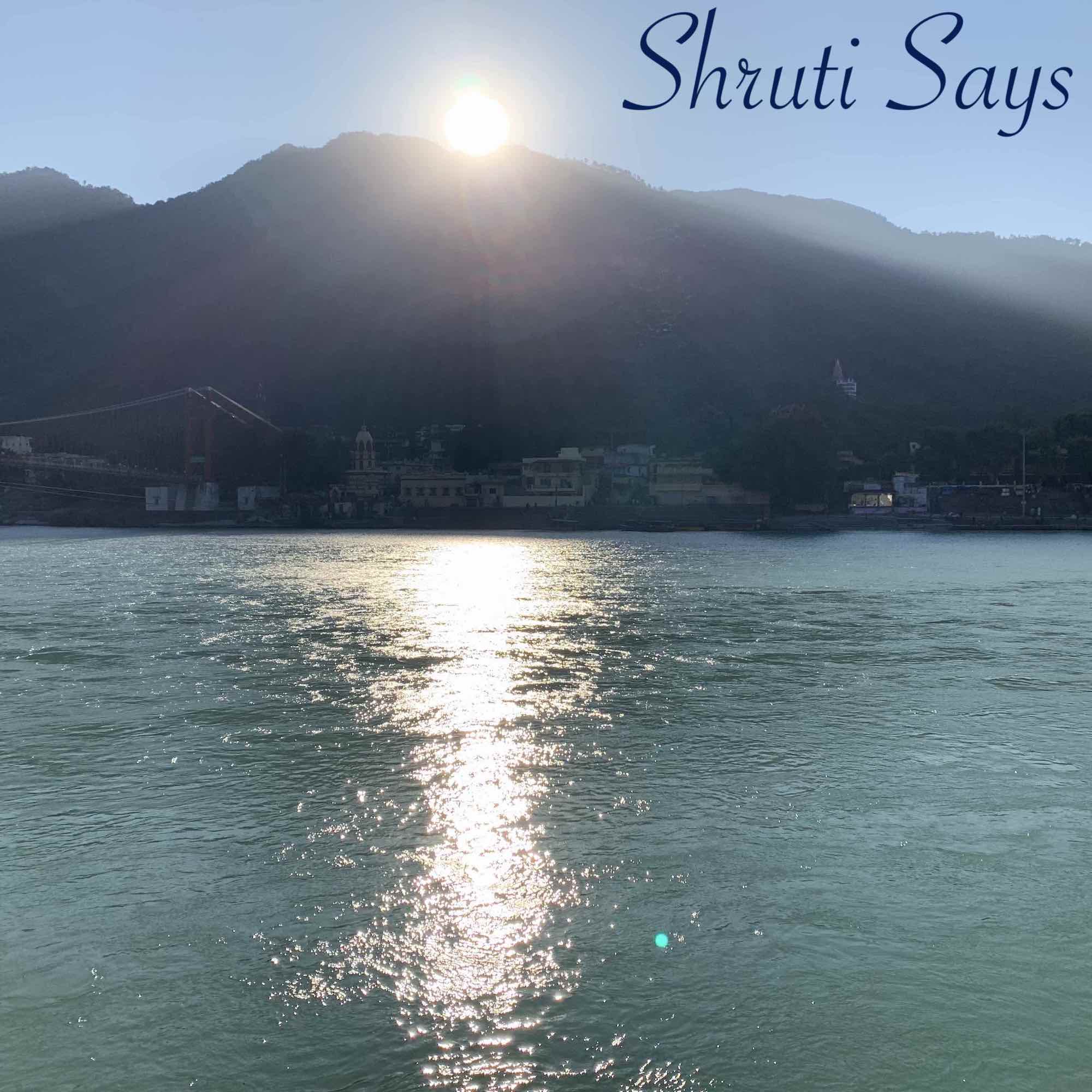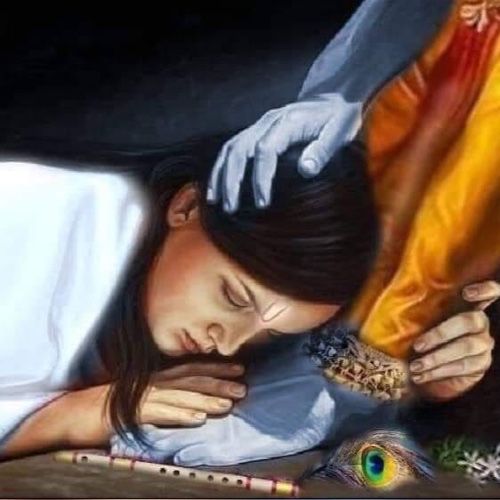Bhagwat Session 14
Shrimad Bhagavata Mahapurana
Synopsis of the Fourteenth Session
Bhagavata Tritiya Skanda (Book Three)
Chapter 10 to 13 (Continued)
—————————————
Swami Mukundnandaji had a very lovely story to tell. He said one day there were two mice, sitting and talking to each other, when they heard a cat meow. One of the mice got so scared and said;
Mice one - Lets run away, run for your life.
Mice two - Don’t worry stay put, I know a foreign language.
Mice one - What ??
Mice Two - Bhaw Bhaw Bhaw Bhaw
Hearing this, it was not the mice, but the cat which ran for its life. The mice had a great laugh.
Moral of the story is knowing a foreign language is very essential. The moral of the story is - Don’t Run Away.
In the spiritual path also there are 4 major types of languages, which are used to understand ’That’
- Vaikhari Vani (Expressing in words)
- Madhyama Vani (Words use in our mind in the process of thinking)
- Pasyanti Vani (Thought in the form of flashes and not words)
- Para Vani (Beyond any form of words and thoughts - you just know it, feel it and understand it)
We all makes attempt to understand and explain in the various ways, but The Eternal can be understood only in Para Vani. All the others are mere attempts to ignite the spark. Beyond the words, you reach the Sat Chit Anand.
Hence, the knowledge of scriptures is passed and gathered with the help of ‘Para Vani’ due to which, the element of distortion in eliminated and what reached is pure unadulterated ‘Gyan’.
The knowledge of our scriptures and that ‘Divine’ is ‘Dynamic’ and not statics. You walk in faith and then you have an experience, with the experience your faith increases and with the increased faith you have deeper experiences, and the understanding becomes better, with this your faith becomes stronger. It goes on.
In others words, you start walking with Bhakti and you get Gyan (true Knowledge), with more Gyan, your Bhakti increases and with increased bhakti more Gyan comes.
This a point in time when Bhakti and Gyan merge.
In our scriptures we will see that many topics are repeated again and again after a certain duration. Cause every time on the journey our understanding will become clear and deeper.
The same scripture when picked up again, after a period of Sadhana will reveal more hidden messages.
So the key is to Keep Walking in Faith.
—————————————
‘All Creations of God stretch Infinitely,
All Times, Past, Present and Future,
Worlds imagined and unimagined..
Everything that Can be,
Everything that Cannot be,
All exist somewhere..
Beyond this world are myriad worlds,
And beyond all worlds,
Is the One that is Eternal..’
——————————————
‘EVERYTIME the Lord exhales, a Universe emerges from EACH of his body pores and with EACH of His inhalations, ALL these Universes merge BACK into His body! The multiple universes generated are floating, and they are scattered all over the Karana Ocean (Causal Ocean).
If ever there is a Grand description of God in World literature, it has to be this one! How infinitesimal and tiny our entire existence appears to be if we humbly give thought to this notion. Our entire lifetimes are nothing, not even a fraction of a second for Lord Maha Vishnu!’
This magnificent act as we see it, is nothing but a mere shadow, in the flood of the divine light.’
——————————————
Points to Ponder
Questions:
1. How many oceans are there?
2. How many types of Vishnu?
3. Which Vishnu did Brahma of the universe come out from?
4. How Big is our universe?
Answers:
Note:
Pls refer to the pictures Galaxy and One universe
- There are three types of ocean as we understand it so far - The Karana (causal) Ocean, the Garbhodak Ocean and the Ksirsagar.
- Garbhodakaśāyī Vishnu is an expansion of Maha Vishnu. There are three types of Vishnu: Maha Vishnu, Garbhodakaśāyī Vishnu and Ksirodakasayi Vishnu. Each form has a different role in the maintenance of the Universe and its inhabitants.For material creation, Lord plenary expansion assumes three Vishnus.
- The first, Maha Vishnu, creates the total material energy, known as the mahat-tattva.
- The second, Garbhodakaśāyī Viṣṇu, enters into all the universe to create diversities.
- The third Ksirodakasayi Vishnu is diffused as the all-pervading super soul in all the universes; in the heart of every living being, is known as Paramātmā. He is present even within the atoms.
- From the Naval of Garbhodakasayi Vishnu came out the Lotus and on it Brahmaji. The stem went upto to the Satyaloka - the Abode of Brahmaji in the universe.
- Our universe is five million Yojans or 40 million miles in diameter. It has 7 sheaths covering it ether, air, fire, water, earth, cosmic intelligence and false ego. Each layer is 10 times larger than the previous one. We have 5 mandals, 7 upper lokas and 7 lower lokas and 3 trilokies.
Questions:
1. Is time - Cyclic or Linear?
2. How many Manus and Manvantars?
3. What is the life cycle of Brahma?
4. What is the duration of the Kalp?
Answer:
Note:
Pls find the detailed answer attached in the sheet - ‘Lets Journey from Pranamu to life duration of Brahma’. Pls also refer to the chart ‘Life of Brahma’
The current Kalp is called the Swetha varaha Kalpa.
Question :
What is Pralaya and types of Parlay?
Answer:
‘Pralaya, in Hindu cosmology, is an aeonic term for Dissolution, which specifies different periods of time during which non activity situation persists, as per different formats or contexts. The word Mahapralaya stands for Great Dissolution. During each pralaya, the lower ten realms (loka) are destroyed, while the higher four realms, including Satya-loka, Tapa-loka, Jana-loka, and Mahar-loka are preserved. During each Mahapralaya, all 14 realms are destroyed.
In the Samkhya philosophy, one of the six schools of classical Indian philosophy, Pralaya means "non-existence, a state of matter achieved when the three gunas (principles of matter) are in perfect balance. The word pra-laya comes from sanskrit meaning 'dissolution' or by extension 'reabsorption, destruction, annihilation or death'.
According to Vishnu Purana and Agni Purana, there are 4 different types of pralay:
- Praakritik Pralaya
- Naimittik Pralaya
- Atyantik Pralaya
- Nitya Pralaya.
Praakritik Pralaya, which is of 311,040,000,000,000 solar years duration, occurs after the completion of life of Brahma (i.e. 100 Brahma years = 311 trillion and 40 billion earth years = one day of Vishnu = 1 Parama). After the completion of one Brahma life cycle, the complete dissolution of all the entities (i.e. the Pancha Mahabhutha or Universe) takes place in the eternity (God). Praakritik Pralaya is the time for which Vishnu sleeps. The next morning, he again gives birth to a new Lord Brahma and asks him to create new worldly entities. Noticeably, Praakritik Pralaya and the Life of Brahma are of equal duration.
Note here:
Some times it is put as one inhalation and one exhalation.
Naimittika Pralaya, which is of 4,320,000,000 earth years, occurs just after the end of a Kalpa. Also, known as the Night of Brahma, it signifies the end of living world. In Bhagvata Purana, sage Shukdeva told king Parikshit that if Lord Brahma is supposed to be a child (for example), then in a similar way as a child plays with his toys i.e. making various structures from his toys during day and breaking or dismantling them before he goes to sleep at night; Brahma makes the living world during his day (i.e. alpa) and destroys it before going to sleep during night (i.e. Naimittika Pralaya). A new living world is created by Brahma, when he wakes up the next day and so on the cycle continues till Praakritik Pralaya. Again, Naimittika Pralaya and Kalpa are of equal duration.
Note here:
It is the fire from Shankarasna located in the Gharbodhak Ocean. That destroys the first 10 Lokas. At this point in time, due to the heat, Rishis residing in the Mahar Loka move up to the upper lokas.
Atyantik Pralaya, also termed as Moksha, is the final deliverance or the attainment of salvation by a jivan (soul) and after that the jivan is never again in the clutches of karma; nor bounded by the tight ropes of Samsara. It is therefore a variable time span conditioned or determined by the practise of the different kind of Yogas or Prapatti. It is the final immersion of a soul (i.e. atma), thereby completely eliminating its individualism into the eternal almighty (i.e. Paramatma).
Nitya Pralaya, is the sleep or by an extension thereof, Death.’
Questions:
1. Is Brahma a designation? Are there more Brahmas?
2. Why Sages like Sanat Kumar are considered created by Prakriti and Vikriti, when they came after Brahma and from him?Why only 3 Lokas were created, we have 14 Lokas or Why only the lower 10 were destroyed and the upper 4 remained?
3. When the creation is yet to begin, how is Hiranyaksha still there?
4. Where did the earth sink?
Answer:
Note:
Pls refer to the Pictures - Maha vishnu and One Universe.
- Brahma is a designation. After his life duration that is of 100 Brahma years. He dies and after Maha Pralay a new Brahma takes his place. There are various Brahmand and each has his own Brahma. Now, our Brahmand is said to be one of the smaller one.
- It is worth nothing here that the life duration of these Sages, is equivalent to the life duration of Brahmaji. Hence, they remain even when the partial parlay (Naimitika Pralay) takes place, after every day of Brahma when he sleeps. These sages are born enlightened and do not need any Guru.
- From the Loka perspective lets take an example. Our body can also be considered a replica of the universe. Each part of the body has a different cycle, destruction and creation, but some are not destroyed till we live.
- For example, neurons are amitotic, or they do not undergo the process of cell division. They are in your body throughout your entire life, and you do not get new neurons once they die. Muscle cells also do not divide.
- ‘The answers given in the Purana’s is worth listening to. Hirayaksha and Hiranyakashipu were not born in that Kalpa. They were creatures of the Padma Kalpa. In which the age ends with everyday of Brahma’s life. Destruction is not total in the end of those ages. During the partial pralay. They consider themselves as monarch of the water. Hence, when the Lord Varaha went to rise up the Earth, Hiranyaksha blocked his path, claiming that earth belonged to him.’ Hence, this kalpa is also knows as the Varaha Kalpa.
- The earth sank in the Garbodhaka Ocean, which is in the bottom of the Universe. In which the Garbodhaksahe Vishnu reside.
Questions
1. Where did Rudra come from?
2. What does the name Rudra signify?
3. What is meant by the 11 Rudra?
4. What is meant by the location of his abode stay?
5. What was Rudra actually destroying?
Answer:
- Rudra came from Brahmaji’s ‘Effort to control his anger’ and not from Brahmaji’s Anger. It is very essential to note. We often say he came from anger which is not so. Hence, as he came from the effort to destroy anger, or we can say vices, that is what he helps us do.
- Rudra is the one who cries - To me, he cries to see the plight of the people trapped in Maya and also cries in the ecstasy for his love for God.
- Lord Shiva is made up of 11 Rudra. Even in Ramayan he tells Parvati the secret of his 11 Rudra and from 1 of it he makes Hanumanji and with the rest 10 he remains with Parvatiji.
- When we actually look at the places located to him to stay(The heart, the senses, the air of life, the sky, the air, the fire, the water, the earth, the sun, the moon and austerity), we realise that he is all pervasive in the universe. He is present from the outer layer( which is made up of ether, air, fire, water, earth, cosmic intelligence and false ego) to every element.
- Now the creation is not free from the various form of vices, it is inflicted by maya. He is the destroyer of all the negativity which is imbibed in the creation. So he and his progeny start to destroy the same. It is worth nothing that even Satyaloka is nor free from the strands of vices it seems.
- Another way to look at it could be that till there is any form of Guna, be it Satya, Rajas or Tamas. The work is not complete. The designation is beyond.
Jai Shri Krishan 🙏
Jai Hanuman 🙏


